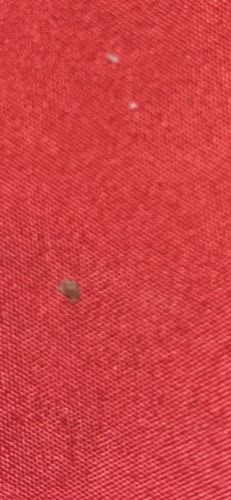Carpet Beetle (larva)
Scientific Name: Dermestes lardarius (Larder Beetle) or similar species within Dermestidae, difficult to specify exact genus/species from image alone, but morphology is consistent with a carpet beetle larva.
Order & Family: Order: Coleoptera, Family: Dermestidae
Size: Larvae can range from 2mm to 12mm depending on the species and developmental stage. The object in the image appears to be a larva, likely a few millimeters in length.

Natural Habitat
Carpet beetle larvae are commonly found indoors in homes and businesses, particularly in areas with natural fibers. This includes carpets, rugs, upholstered furniture, clothing, blankets, stored food products, and even inside museums or taxidermy collections.
Diet & Feeding
The larvae of carpet beetles feed on natural fibers such as wool, silk, fur, feathers, and dried animal products like pet food or dead insects. They are also known to eat synthetic fibers if mixed with natural ones. Adult carpet beetles feed on pollen and nectar from flowers.
Behavior Patterns
Carpet beetle larvae are typically found in dark, undisturbed areas where food sources are plentiful. They are slow-moving and tend to cling to fabrics or other materials. The larvae will molt several times before pupating and emerging as adult beetles. Adults are winged and can fly, often seen near windows as they are attracted to light.
Risks & Benefits
Potential risks include significant damage to natural fiber belongings, textiles, and museum collections. Some people may develop skin irritations or allergic reactions from contact with carpet beetle hairs or remnants (known as carpet beetle dermatitis). They are generally not harmful to humans directly and do not transmit diseases. Benefits are minimal in a domestic setting; in nature, they play a role in decomposition by feeding on carrion and dried organic matter.
Identified on: 9/4/2025